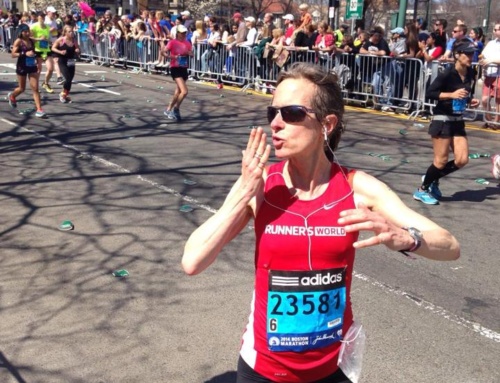
If you’ve hung around Another Mother Runner for more than a mile, you know that we’re not shy about TMI. And while we can’t deny that we love a little vicarious living, we also know there is great comfort in both knowing you’re not alone in those embarrassing moments and crowd sourcing the situation for future solutions. Because if you’ve dropped your only tampon at mile 11 of a marathon in a port-a-potty, somebody else certainly has as well. (Although we’re not certain there’s a true solution for that…)
In April, we are going to hit on a few TMI mainstays here on the website and on the Friday podcast. We’re starting with one that hopefully won’t make you blush: chafing during a run.
At its most basic, chafing is simply friction from two surfaces rubbing together: either skin-on-skin or skin-on-fabric. Could be in your armpit, between your thighs, under your chest, or pretty much anywhere.
Step #1: Stop chafing before it even starts.
Pick your clothing wisely.
We trust you know this already, but forgo wearing anything cotton. No Napoleon-inspired tube socks, no college tee from 1995, no cute “gym” shorts you bought at the leisure section at Target. You can likely sport a cotton/poly blend tee for a short, easy run, but on really hot days or really long runs, you will want be donning your favorite wicking, technical fabrics.
Once you’re in technical fabrics, realize that the fewer seams, the better. We’re looking for smooth and simple, especially in sports bras and undies (read: near your most sensitive skin). Find some of our favorite sports bra here, while we love these running undies.
Once you’ve got the fabrics dialed in, time to turn it tighter. As in, the tighter your clothes fit, the better. (And yes, we promise that you look much better in clothes that fit and flatter instead of float around you.)
Start with running shorts with a longer inseam and/or a more compressive, form-fitting silhouette will discourage any “chatter” between your thighs. We review some of our favorite running shorts here. (Side note: if your thighs like to chat under summer skirts while at work, these Bandalettes look promising.)
For your upper half, find a bra that supports you 100%. Boobs don’t slide against each other, the whole package doesn’t shift substantially when you jump up and down. The ability to adjust both band width and shoulder strap height is key; you want to make sure you feel locked and loaded, as your chest will definitely accumulate sweat.
Wear a waist pack or arm band? Snug them up! They should also be tight and move as little as possible.
Finally, clip those tags! Our kids already notice everything, so nobody needs a back-of-the-neck “hickey” courtesy of your running tank.
Step #2: Ease the chafing:
Decrease intensity of friction.
Even if you’ve picked your outfit with as much discretion as an Emmy-nominated actress does, you still run the risk of chafing. Humidity increases chances of little red wounds, as does warm weather in general; the more you sweat, the better chance of chafe.
There are plenty of choices for decreasing the friction of chafing. No matter what you choose, here’s our advice: apply early and often. There’s a reason why marathon fans offer up DIY Vaseline applicators. If you’re running long, bring a little extra lube. You may not need it, but you’ll be really glad you have it if you do.

Crowd sourcing time: You all offered up some great ideas in this post.
“I use Shea Butter Vaseline under my bra straps and heart rate monitor straps. Works like a charm and much cheaper than Body Glide.” —Amanda H.
“None of the glides or topical anything works for me. I use a lot of strategically placed large band aids.” —Anne O.
“A&D ointment does wonders and it’s cheaper than most of the recommendations.” —Denée H.
“Chamois Butt’r. They also sell little 1 oz. packages that I put in my hydration vest pocket and reapply if needed during my run. It works much better for me than glide — and doesn’t leave grease stains like petroleum jelly.” —Nicole R.
“I recently tried KT tape under my bra where it tends to chafe. It worked like a charm! Nothing else I’ve tried helped.” —Holly T.
“Tri-Slide triathlon anti-chafe spray! But spray it on outdoors — if you get it on your floor, it will literally be slippery for weeks.” —Roberta S.
“Chafex. I like it more than Body Glide. I met the inventors at Hartford Marathon expo years ago. Great guys who really focus on the science of eliminating as much chafing as possible. These hot days of summer training make chafing so tough!” —Kate P.
“I don’t go on runs longer than 6 miles without Sport Shield for Her. It’s a life saver. I also rub it on my toes and heels to prevent blistering before longer runs. I’m a DD so I chafed HORRIBLY before I found this stuff.” —Aryn S.
“Dove deodorant works so much better for me than the body glide.” —Sasha M.
“Before I have any chafing, I use Aquaphor. For summer long runs, if I’ve already gotten chafe-y, I tuck Spenco Second Skin into the strap of my bra to ease discomfort.” —Shayna D.
Step #3: A BOGO chafing solution:
Stay hydrated.
If you’re running on a hot and/or dry day, drink like you mean it. Staying hydrated doesn’t just help your performance; it also prevents your skin from developing sand-paper-like gritty feel that encourages chafing.
When you drink regularly on the run, you sweat keeps pouring, which washes away the salt on the surface of your skin. Less salt on your skin equals less friction.
Step #4: Ease the sting.
If, despite your best efforts, you come home with a hot spot in your ‘pit, on the back of your neck, under your chest, or between your legs, treat it gently.
Start with a lukewarm shower; do not start with a steaming hot shower, unless you want to run faster out of the shower than you did on your run. Gently clean the area, then pat it dry.
An antibacterial ointment like Desitin or Neosporin can speed healing. Looking for something more natural? Try aloe vera gel or coconut oil mixed with a drop of lavender oil.






When it’s hot, I wear most of my running tops inside out. Move all seams to the outside. People will politely tell you that you put your shirt on inside out. Yes, I know, I did it on purpose! I also highly recommend a wardrobe change mid-run during hot weather long runs. A fresh set of dry clothes can make a huge difference.
The last half marathon cycle a friend introduced me to Squirrel Nutbutter and it has helped tremendously: https://squirrelsnutbutter.com/
Monistat makes a fantastic chafe relief gel. It goes on like a gel, and disappears like a powder. It’s soft and lasts me the entire race! Find it where you find other Monistat and KY products.